Christopher Wheeldon’s Cinderella and Matthew Bourne’s Sleeping Beauty update classic scores and fairytales.
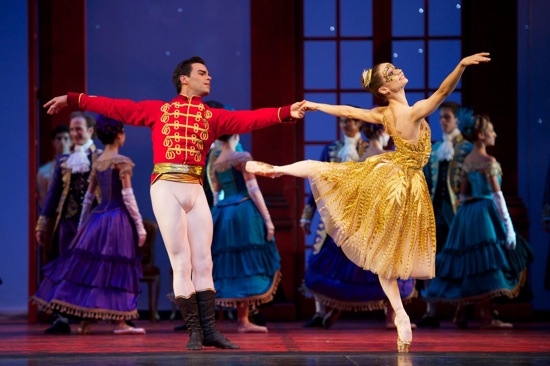
Joan Boada and Maria Kochetkova of the San Francisco Ballet in Christopher Wheeldon’s Cinderalla. Photo: Erik Tomasson
When it comes to fairy tales danced out onstage, the borderline between what’s logical in magic worlds and what gives rise to questions is often blurred. The San Francisco Ballet’s production of Christopher Wheeldon’s Cinderella at Lincoln Center and the British New Adventures production of director-choreographer Matthew Bourne’s Sleeping Beauty at City Center prompt thoughts about believability within fantasy.
If I read the Grimm brothers’ tale of Cinderella, I accept the fact that the glass slipper will fit only her. Some pre-radar magic spell draws the shoe to its owner’s purity and goodness. Seeing Wheeldon’s wonderfully exaggerated shoe-fitting, when the line of women waiting for the test goes out the door, it occurs to me how odd it is that not a single girl in the kingdom wears that size shoe. (Maybe one day someone will design a shoe that lights up when Cinderella’s toe touches it.) When the heroine’s nasty stepmother and stepsisters go to the ball, all the women there are wearing Julian Crouch’s gorgeous, identically cut gowns in jewel tones, which allows them to blend colorfully in the dance patterns. Their outfits suggest that they’re courtiers obeying a dress code, which means that out of the stack of invitations the prince was ordered to deliver, only one family, Cinderella’s, decided to come.
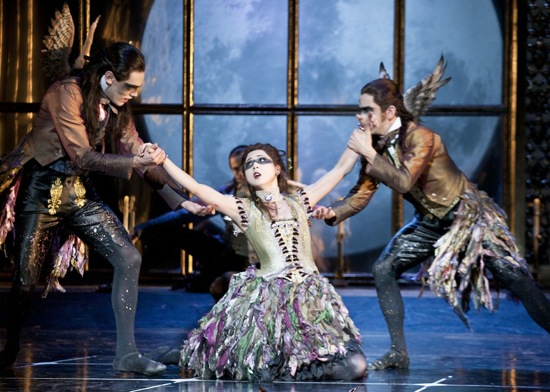
Three of the Fairies from Matthew Bourne’s Sleeping Beauty. (L to R): Tom Jackson Greaves, Mari Kamata, and Joe Walkling. Photo: Simon Anand
Bourne, who strays much, much farther from the plot of the Sleeping Beauty ballet that we know, asks us to believe that the rulers of this fantasy kingdom, unable to conceive a child, asked the wicked fairy Carabosse to provide a baby for them. Would she be your adoption agency representative of choice? They didn’t ask her where she got the kid either, and Bourne’s whole story is set in motion because they forgot to say ‘thank you’?! A tall, pale, powerful fairy dressed in black and wearing blood-red lipstick (Adam Maskell) brings an infant to the infertile royal couple and they show no gratitude whatsoever? This is beyond “oops.”
One can’t forget this odd situation, because Aurora is mischievous from the get-go. As an adorable life-sized baby (a puppet with three almost invisible handlers), she crawls away from those in charge of her, hides, even clambers up curtains. And when the fairies—those decreed by Peter Ilyich Tchaikovsky’s score and the scenario that Marius Petipa followed back in 1890—dance their variations for the infant princess, she bangs time on the rim of her bassinet, not caring that among the male and female fairies, three are called Ardor, Feral, and Tantrum, and all their wings are gray. Small wonder that she (Hannah Vassalo) grew up headstrong and romped erotically with Leo, the Royal Gamekeeper (Chris Trenfield), to the music that Tchaikovsky wrote for the “Rose Adagio.”
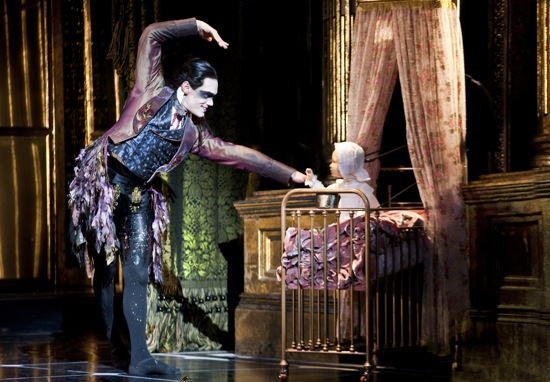
Tom Jackson Greaves as Fairy Tantrum and the infant Princess Aurora in Bourne’s Sleeping Beauty. Photo: Simon Annand
Both of these works—one made for a ballet company of gifted dancers, the others an assembly of excellent performers trained in ballet, modern dance, and theater (or a blend of these)—both honor and deviate from the handed-down scenarios, while using the original music. Wheeldon’s Cinderella (a work created for both the SFB and the Dutch National Ballet) is performed to Sergei Prokofiev’s magnificent score, played by the New York City Ballet Orchestra under the baton of Martin West. Tchaikovsky’s magisterial music plays on tape for Matthew Bourne’s Sleeping Beauty: A Gothic Fairy Tale (yes, that’s its full title).
Both works boast exceptionally beautiful décor, including, at one point, a suspended row of chairs, turning gently in unseen breezes in Cinderella. In addition to Crouch’s splendid sets and costumes for Wheeldon’s ballet, master puppeteer Basil Twist has created two astonishing effects. One is the tree that grew from the tears that Cinderella wept at her mother’s grave; by the time she has come of age in her life of drudgery, the tree is massive—its layered clusters of greenery gently rising and falling to create luxuriant foliage.
Nature plays a role in this Cinderella. Fairies representing the four seasons (Clara Blanco, Jaime Garcia Castilla, Hansuke Yamamoto, and Sasha De Sola, plus their entourages) “teach” the heroine the dance steps she should know. Unaided by a fairy godmother who is resourceful about pumpkins, Cinderella slips into the tree trunk and emerges in a ball gown. To create her coach, the four Fates who track her through life (and sometimes carry her around) bring wheels and make them turn, and the utterly amazing finale sends her to the palace atop a “carriage” with an arch of billowing white silk forming its roof. This apparition rolls straight toward the audience as Natasha Katz’s magical lighting fades and the Act I curtain descends. In the final happy ending, the tree’s leaves and the palace’s chandelier dance together.
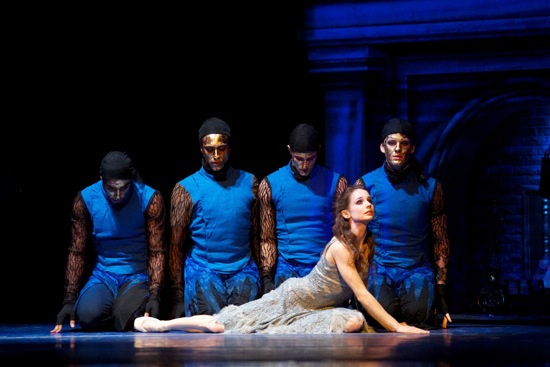
San Francisco Ballet’s Cinderella (Maria Kochetkova) and her four Fates in Wheeldon’s Cinderella. Photo: Erik Tomasson
Lez Brotherston’s sets and costumes for Bourne’s Sleeping Beauty are also magical, especially— with the aid of Paule Constable’s lighting—in the opening of Act II. The spicy, rambunctious Aurora comes of age in a 1911 party on a terrace, with slim young men in white flourishing their tennis rackets and their girls flirting and gossiping. In the distance, far up on a green hill, sits the painted palace, and when darkness falls, its tiny windows light up. Impressive too are the sliding floor panels that bear nymphs in corsets who populate Leo’s vision of the sleeping princess’s domain; the moving floor also figures in the “panorama” when Count Lilac (Christopher Marney) leads Leo—a prince of an ordinary guy—deeper into the woods.
Cinderella is not, to my mind, the equal of Wheeldon’s 2004 Swan Lake for the Pennslvania Ballet, but he tells the story excellently well for the most part and provides some nice humorous touches, as well as a few over-the-top ones (the nastiest stepsister, portrayed with passion by Vanessa Zahorian, returns from the ball with the overskirt of her gown missing and a gentleman who looks as if he’s had to put on his clothes in a hurry and be hustled out of sight; the stepmother, played by Marie-Claire D’Lyse, throws up after over-imbibing).
Wheeldon has also given Prince Guillaume (Joan Boada) a chum, Benjamin (Taras Domitro). We see them as children romping together and, as young men, neglecting their responsibilities as noblemen. As an in-joke, Wheeldon has them shake hands behind their backs in congratulation, like the sailors in Jerome Robbins’s Fancy Free. One beguiling touch: when the King (Ricardo Bustamente) and Queen (Anita Paciotti), try to interest Guillaume in possible brides, Benjamin, behind the royal family, does brief mocking imitations of the candidates pictured (in projections) on the wall. They are all horrid in one way or another, and when dismissed by the Prince, come to life and look grumpy. Benjamin ends up with the younger and marginally nicer stepsister (Frances Chung, wearing spectacles).
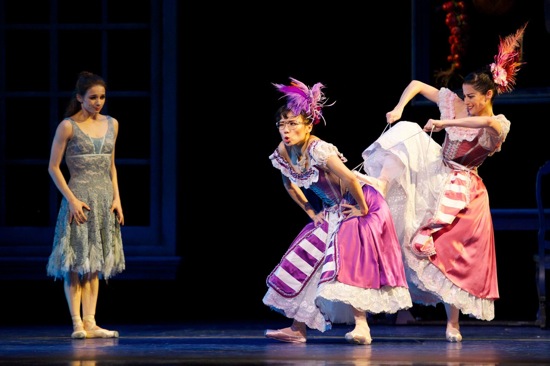
The heroine (Maria Kochetkova) and her stepsisters, (L to R): Clementine (Frances Chung ) and Edwina (Vanessa Zahorian) in Cinderella. Photo: Erik Tomasson
The young men deliver invitations with Benjamin disguised as Guillaume and Guillaume disguised as a beggar craving food. So he falls in love with Cinderella before she comes to the ball, and they dance sweetly together, she a bit reluctant and standing on his feet. Strangely, the role of Cinderella herself seems underdeveloped, and that fact weakens the drama a little. Maria Kochetkova is lovely—meek and delicate—and she dances beautifully. But we never see the resourcefulness that allows her to swallow her pride, nor how hurt she must be that her henpecked father (Damian Smith) doesn’t stand up for her. Thanks to those strange, gold-faced Fates (Gaetano Amico, Daniel Deivison, Anthony Spaulding, and Shane Wuerther), who do a lot of the heavy housework for her (and a lot of vivid dancing), we don’t really see how very hard Cinderella’s life is.
Wheeldon makes, as usual, choreography that’s very expressive and good to look at, while weaving his ballet around and in and out of the various versions of the tale. Bourne has the original choreography of Sleeping Beauty to allude to, as he does in the Fairy Variations, although, interestingly, Petipa’s variations were so finely structured that they seemed very short, whereas each of Bourne’s fairies (Marney, Mari Kamata, Kate Lyons, Joe Walkling, Ashley Shaw, and Liam Mower) dances for what feels like rather a long time, perhaps because they hurl themselves about so furiously (the men) and romp so flirtatiously (the women).
In the 1890 Sleeping Beauty, Prince Florestan didn’t appear until Act II, when, ill-at-ease among his friends, he took the Lilac Fairy up on her invitation to view (by magic) Aurora dancing among a bevy of nymphs. So he was pursuing a woman he had never met. Bourne wanted his “prince” and Aurora to meet and fall in love early on, which decision adds to the drama of their situation. But that resulted in a problem. Having pricked her finger on a black rose that Carabosse’s son, Caradoc (also played, with lustful, venomous relish by Maskell), slipped to her, she’s out of commission for 100 years. And warm-hearted, easy-dancing Leo, whom she loves, will be long dead when she wakes up. The solution? Make Count Lilac and his fairy band vampires. As the curtain descends on a scene at the briar-covered gates of the castle, Count Lilac reveals a gleaming set of teeth and sinks them into Leo’s neck. Now he will live forever. That he will live as a vampire seems not to matter.
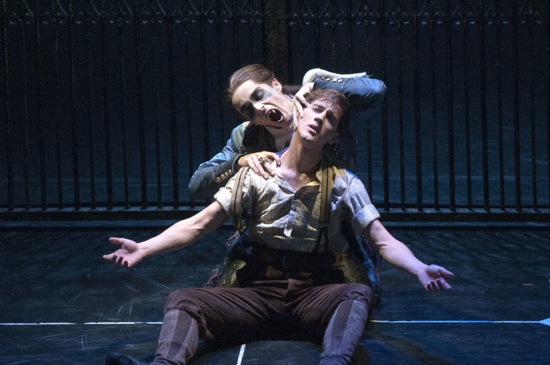
Count Lilac (Christopher Marney) changes the life of Leo (Dominic North) in Bourne’s Sleeping Beauty. Photo:Mikah Smillie
Bourne’s Beauty—so smart and entertaining at the start—gets messier and the drama becomes enmeshed in confusion. Leo kisses the comatose Aurora, but is snatched away by Caradoc before she can fully waken and see him. Then, in disguise and wearing his vampire-fairy wings, he penetrates her welcome-awake party, which is populated by a crowd of agile, 21st-century vampiric swingers dressed in red. But the princess is still asleep. There’s one of those limp-woman-manipulating-man duets, this one to the “Puss and Boots” sequence from the traditional Sleeping Beauty. Caradoc lusts after her to no avail. Count Lilac keeps stopping Leo from making a move too soon (not sure exactly why), but when Caradoc enters, bare-chested with a pair of vampire wings for Aurora, Lilac stabs him, and a fight ensues between the two rival fairies.
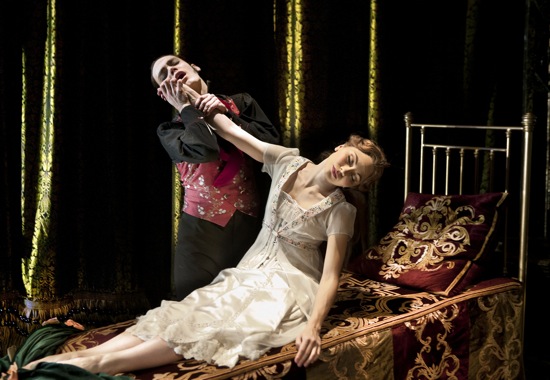
Adam Miskell as Caradoc cannot awaken Aurora (Hannah Vassallo) in Matthew Bourne’s Sleeping Beauty. Photo: Simon Annand
Eventually, Leo, worried that Aurora is dead, kisses her again (to, as I recall) the music that usually accompanies the grand pas de deux. She awakes scared. But for now: back to bed, this time with Leo; the fairies cover them fondly. But apparently, the vampire crowd has more than one new recruit. Aurora has not only crossed long-gone social barriers in marrying Leo, she has crossed quite happily over to the realm of the undead. The two advance for the audience’s applause, both sporting black wings, and leading their puppet baby, who has tiny wings just like Mummy and Daddy’s. I do not allow myself to wonder whether Bourne has considered their gruesome daily task of heating blood to mix with their child’s milk.
The audience laughs. But the ending of Bourne’s work brings me back to what I said about believability in fantasy making the magic even stronger and the lack of it becoming a diluting force. And here’s another thought. This long-sleeping princess awakes in 2011—well before September 11th, I presume. That date, in any case, may not reverberate in fairyland.
